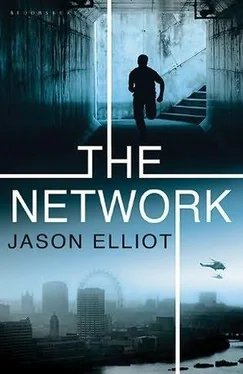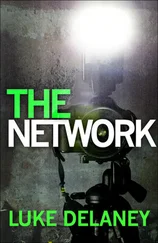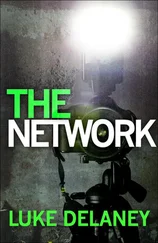Jason Elliot - The Network
Здесь есть возможность читать онлайн «Jason Elliot - The Network» весь текст электронной книги совершенно бесплатно (целиком полную версию без сокращений). В некоторых случаях можно слушать аудио, скачать через торрент в формате fb2 и присутствует краткое содержание. Жанр: Триллер, на английском языке. Описание произведения, (предисловие) а так же отзывы посетителей доступны на портале библиотеки ЛибКат.
- Название:The Network
- Автор:
- Жанр:
- Год:неизвестен
- ISBN:нет данных
- Рейтинг книги:4 / 5. Голосов: 1
-
Избранное:Добавить в избранное
- Отзывы:
-
Ваша оценка:
- 80
- 1
- 2
- 3
- 4
- 5
The Network: краткое содержание, описание и аннотация
Предлагаем к чтению аннотацию, описание, краткое содержание или предисловие (зависит от того, что написал сам автор книги «The Network»). Если вы не нашли необходимую информацию о книге — напишите в комментариях, мы постараемся отыскать её.
The Network — читать онлайн бесплатно полную книгу (весь текст) целиком
Ниже представлен текст книги, разбитый по страницам. Система сохранения места последней прочитанной страницы, позволяет с удобством читать онлайн бесплатно книгу «The Network», без необходимости каждый раз заново искать на чём Вы остановились. Поставьте закладку, и сможете в любой момент перейти на страницу, на которой закончили чтение.
Интервал:
Закладка:
As darkness falls we take the scarf from the Talib’s head and, this being Afghanistan, allow him to eat with us because there are courtesies to be observed. Then we tie his hands again, and return him to the metal bed of the pickup with a blanket.
The colour of the sky turns imperceptibly from turquoise to an ever-deeper purple, and we see the first stars appear. Above us, silhouetted against the sky like a primeval saw blade, lies the ridge to which we’ll walk in the morning, and from which we’ll have a view, at long last, of the place we’ve come so far to see.
15
The fort stands on a high narrow spur with a commanding view of the valley below. It is perhaps a hundred years old, and built in the form of a perfect square, the walls linking four circular bastions with defensive slits in their upper sections. A driveable track, cut into the steep approach from the front, links it to the valley floor in a coil of tight switchbacks. Behind the fort and on its flanks the barren slopes of the mountains rise another thousand feet or more. The closest of these rising slopes is at least 300 yards distant. Nearer to, a footpath leads from the side of the fort over the shoulder of the spur and into the next ravine, and a bigger track gives access to the ravine on the other side. They are too steep to be negotiated by vehicle. On the neck of the spur overlooking the fort sits a Soviet BMP like a stranded turtle, abandoned at least a decade ago and stripped even of its wheels. There’s no sign of life from within the fort other than a tiny plume of grey smoke, which drifts silently skyward from the central courtyard. It’s a picture of rural peace.
From a nest of boulders on a ridge above our final lying-up point, H and I have been watching through the Kite sight since dawn. Sher Del is with us, taking turns to peer at the target, and agrees that there’s nothing to indicate we shouldn’t drive there and back again without any surprises.
At 10 a.m., as the sun begins to lose the innocence of early morning and climbs with growing strength into the clear sky above, H looks at his watch and then at me.
‘We shouldn’t wait much longer,’ I say.
‘Then let’s go to work.’
We scramble down into our little camp, where Momen and Aref are nursing a kettle over a small fire. Our captive sits cross-legged on the ground with a scarf still tied over his head and his hands fastened behind his back.
‘Time he went back to find his donkey,’ says H after we have packed up the vehicles and are ready to leave. He cuts the cord on the Talib’s wrists and unties the scarf. We give him a glass of tea and he drinks it in silence with a strangely matter-of-fact expression. Then H gives him enough money for a few days’ food.
‘Now fuck off and get a proper job,’ says H, the gist of which Aref kindly translates. He’ll walk down into the village, get his bearings and begin the long walk back to his headquarters, by which time we’ll be long gone.
We drive to the valley floor and then ascend again, winding up through the dust until, beyond the final bend, the fort looms suddenly above us. The walls are about fifty feet high and broken only by a giant pair of wooden doors, within which a smaller door the size of a man is framed. Aref and Sher Del walk to it, rattle the heavy iron loops and exchange some words with a voice on the far side. The small door opens and a turbanned armed man emerges. After a few minutes he goes back inside and the two main doors swing open. We drive in.
A double storey of dilapidated rooms runs around the wide central courtyard. Above them the turrets are linked by a narrow earthen parapet. It’s strange to think that in London we’ve seen a satellite photograph of this very place. The two guards are local men, who tell us they’ve kept watch over the place for the past month. They both have AKs, and when H asks what other weapons they have they point to a PK light machine gun in one of the turrets and an RPG-7 grenade launcher in a corner of the courtyard, beside which lie several bulbous rounds.
The two guards ask whether, now that we’re here, they can leave. For a small sum we persuade them to stay a little longer.
‘Get one of them on stag up there,’ says H, pointing to one of the turrets. ‘We don’t want to be interrupted. Then get the others to turn the vehicles around and tell them to come and help.’
One of the guards leads us to a door and unlocks the padlock that secures it. Inside it’s about the size of a double garage, and is half-filled with a brooding mound covered in dusty tarpaulins. We pull them off, throwing up a bright slanting wall of dust made suddenly luminous by the sunlight. There’s an assortment of crates and black boxes, which we stand before in silence. I can’t really believe it’s them. Ten million dollars’ worth of missiles, give or take.
‘We could go into business with this lot,’ says H. ‘Come on.’
With the second guard we work in pairs, hauling everything from the room and laying it out in the courtyard like bodies in a morgue. Some of the missiles are in their original plastic weatherproof cases; others are in wooden crates; and some are wrapped up in sacking which we have to cut through. There are a few surprises. Three of the missiles are British-made Blowpipes, and there are half a dozen Soviet surface-to-air missiles. There’s also a Soviet 82-millimetre mortar with several boxes of ammunition.
‘Good piece of kit, that,’ says H, rubbing the stubble on his chin. ‘Seems a shame to blow it up.’
H and I work from opposite ends, photographing the serial numbers and logging the condition of the battery units in our notebooks. One by one our men return them to the room and pile them around a central open space. It takes us more than two hours. Then, as they look on, brushing the dust from their clothes, we unload the explosives from the G.
The layout of the explosives takes the form of a chain of two circuits, linked together. In the unlikely event that the primary circuit fails to detonate, the secondary will fire, detonating the first in the process by the power of the blast. Detcord firing systems with detcord priming are the safest, so we lay a long circular length of the bright orange cable over the pile for a ring main, and tie on six shorter lengths as branch lines leading to the individual charges. The plastic explosive is toxic so we leave the blocks in their paper covering, wrap each one with several turns of detcord and place them among the missiles. One of them will go into the central space that we’ve left open for the purpose. It’s probably not necessary but reassures us. The process reminds me faintly of arranging Christmas lights on a tree.
Then we repeat the same system, using the detonators, which we tape to the six ends of each branch line. Then we make a cut into each block of plastic so as to enclose the detonators in cosy beds of high explosive.
‘They call this the direct insertion method,’ says H.
‘Please don’t make me laugh,’ I say.
‘Case of beer would go down well after this.’
‘I’ll take the juice of a Kandahari pomegranate,’ I say, savouring the thought.
Then, as final back-up, we attach time pencils to the detcord. If the blasting fuse fails, the pencils will fire after thirty minutes. All that remains is to attach the two final detonators, one for each circuit, and the time fuse.
‘Time to get the vehicles out,’ says H, and begins unwinding the reel of fuse.
I start up the G and drive it out of the gates, and the others follow with the pickup. Our engines are running. The two guards clamber into the bed of the pickup and cling a little anxiously to the sides. Then I walk back to H as he lays out the fuse in a long trail around the deserted courtyard.
Читать дальшеИнтервал:
Закладка:
Похожие книги на «The Network»
Представляем Вашему вниманию похожие книги на «The Network» списком для выбора. Мы отобрали схожую по названию и смыслу литературу в надежде предоставить читателям больше вариантов отыскать новые, интересные, ещё непрочитанные произведения.
Обсуждение, отзывы о книге «The Network» и просто собственные мнения читателей. Оставьте ваши комментарии, напишите, что Вы думаете о произведении, его смысле или главных героях. Укажите что конкретно понравилось, а что нет, и почему Вы так считаете.












